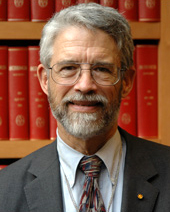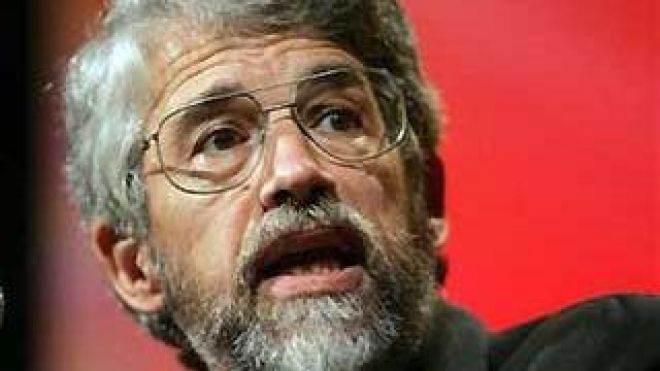| USGS scientist Justin Hagerty was one of the 2012 recipients of the President's Early Career Award for Science and Engineering. |
Dr. Justin Hagerty, a research geologist with the U.S. Geological Survey, was named one of President Obama's recipients of the Presidential Early Career Award for Scientists and Engineers, the highest honor bestowed by the United States government on science and engineering professionals in the early stages of their independent research careers.
Hagerty, an accomplished research geologist, studied the formation of the Moon and discovered the answer to a long-standing riddle of the Moon’s early history. His use of chemical tracers and remote sensing data allowed him to discover why certain elements are concentrated in some areas and not in others, a puzzle which had complicated the primary theory of how the Moon came to be.
"Discoveries in science and technology not only strengthen our economy, they inspire us as a people." President Obama said. "The impressive accomplishments of today’s awardees so early in their careers promise even greater advances in the years ahead."
The Presidential early career awards embody the high priority the Obama Administration places on producing outstanding scientists and engineers to advance the Nation's goals, tackle grand challenges, and contribute to the American economy.
"It is a tremendous and highly unexpected honor to receive such a prestigious award, and I am very grateful for all of the opportunities and support I have received throughout my career, particularly at the USGS," said Hagerty. "Because my research is based on combining data from a variety of disciplines, I have had the opportunity to work with many talented colleagues from varied backgrounds who have helped to shape my career."
"The USGS traces its program in astrogeology back nearly 50 years to the Nation's need to train astronauts destined for the Moon in lunar geology," said USGS Director Marcia McNutt. "The President's recognition of Justin Hagerty for his contributions to explaining long-standing paradoxes concerning the early evolution of the only extraterrestrial body to which man has yet ventured is one of the highest honors yet for this exceptional program."
The commonly accepted theory of how the Moon formed hypothesized that a Mars-sized planetary body collided with a proto-Earth. This massive collision led to the creation of the Moon and the Earth as we know them today. However, one major issue with this theory is that, based on models of such a collision, there should be an even, global distribution of certain elements like potassium, uranium, thorium, and the rare earth elements.
Instead, these elements are mostly concentrated in the hemisphere of the Moon that faces the Earth. To learn why, Hagerty studied expanses of geologic materials on the far side of the Moon called basalt ponds.
Lunar basalts are much like basalts on the Earth in that they are a product of melting the mantle, which is the area between the crust and the core of the Moon. Given this information, it is possible to use compositional data derived from the basalts to learn about the composition of the lunar interior. Much focus has been placed on basalts on the near side of the Moon, primarily because the Apollo missions only returned samples from that part of the lunar surface. However, it is now possible (and necessary) to use a combination of lunar sample analysis and remote sensing observations to investigate materials on the lunar far side, thus giving us a global context.
His research shows that another major impact event on the Moon, now known as the South Pole-Aitken Basin, greatly disrupted the early formation of the Moon, resulting in the migration and eventual concentration of these elements to the side of the Moon that faces the Earth.
"I have also used the methodology of combining sample and remote sensing data to investigate other unresolved issues in lunar science," added Hagerty. "In particular, I worked with several colleagues to establish the existence of silicic volcanic domes on the Moon."
It was previously thought that silicic volcanoes, which erupt silica-rich materials like quartz, instead of the more common basalts, were not possible on the Moon. To explain the origin of these features, Hagerty developed a new model for how such features could be produced in the unique lunar environment. This model demonstrates that silicic lunar volcanoes can be produced quite easily and likely comprise a much larger portion of the lunar crust than was thought. These results have important implications for crustal formation models and calculations of the bulk composition of the Moon.
Hagerty's results are critical to understanding the early history and evolution of our closest celestial neighbor.
"Prior to graduate school, I, like many people, had assumed that the Moon was a dull, lifeless body," said Hagerty. "However, after having the opportunity to learn from experts in lunar science and to examine lunar sample and remote sensing data myself, it quickly became apparent that the Moon is an extraordinary planetary body and that we have only scratched the surface of truly understanding how the Moon formed and evolved. To have an opportunity to play a role in shaping our cumulative knowledge of the Moon is a humbling experience."
Hagerty is currently the curator of the USGS Meteor Crater Sample Collection, as well as the Chair of NASA's Regional Planetary Image Facility Network.
The USGS Meteor Crater Sample Collection is an ongoing project funded by NASA that analyzes drill samples from Meteor Crater and makes the samples available to the planetary science community. The NASA Regional Planetary Image Facility Network is an international system of planetary data libraries that maintains a wide range of data products from NASA planetary missions including photographs, maps, films, engineering plans, and historical documents and artifacts. The overriding mission of the Network is to make these materials available to the public.
Hagerty earned his Ph.D. in Earth and Planetary Sciences from the University of New Mexico, Albuquerque, in 2004; his M.S. in Earth and Planetary Sciences from the University of New Mexico, Albuquerque, in 2001, and his B.S. in Earth and Planetary Sciences, with Honors, from the University of New Mexico, Albuquerque, in 1998. He was a post-doctoral fellow at the Los Alamos National Laboratory from 2004-2007, where he studied lunar geochemistry.
Hagerty came to the USGS in 2007, joining the USGS Astrogeology Science Center in Flagstaff, Arizona. He has been the principal investigator on eight NASA studies and collaborated on an additional four studies. His research has examined not only lunar geochemistry, but also lunar mapping, asteroid mapping, and impact cratering.
Hagerty’s official citation from the Award reads:
Department of Interior/US Geological Survey
Justin J. Hagerty
U.S. Geological Survey
For cutting edge research fusing remote-sensing data of the Moon with laboratory measurements to establish a new coherent model of the lunar crust and mantle and for leadership and service contributions for an international network of 17 Regional Planetary Image Facilities.
The Presidential Early Career Awards for Scientists and Engineers was established by President Clinton in 1996, and are coordinated by the Office of Science and Technology Policy within the Executive Office of the President. Awardees are selected for their pursuit of innovative research at the frontiers of science and technology and their commitment to community service as demonstrated through scientific leadership, public education, or community outreach.


 , Holdren
and his co-authors spend a portion of the book discussing
possible
, Holdren
and his co-authors spend a portion of the book discussing
possible